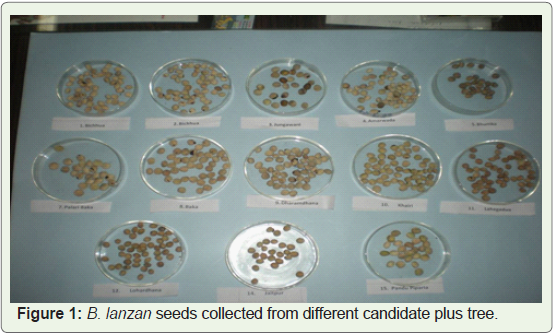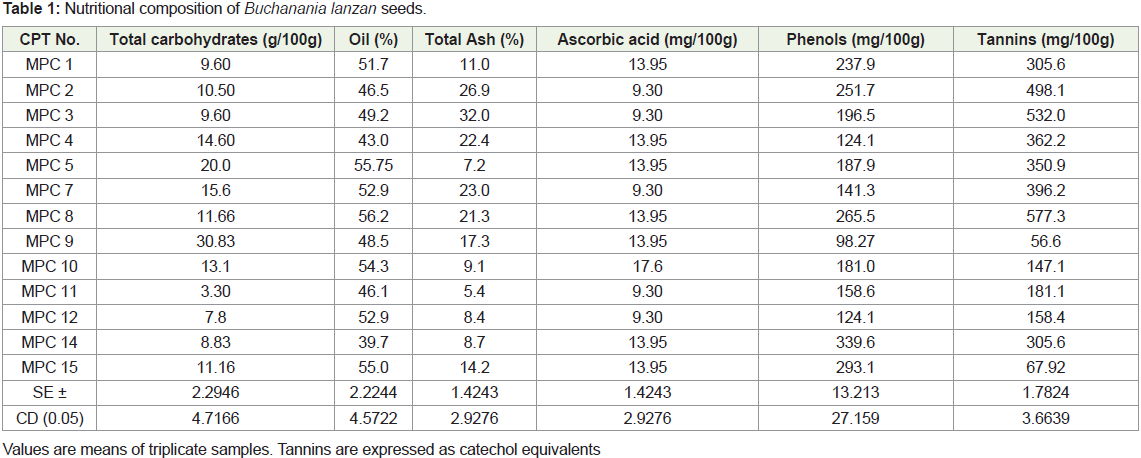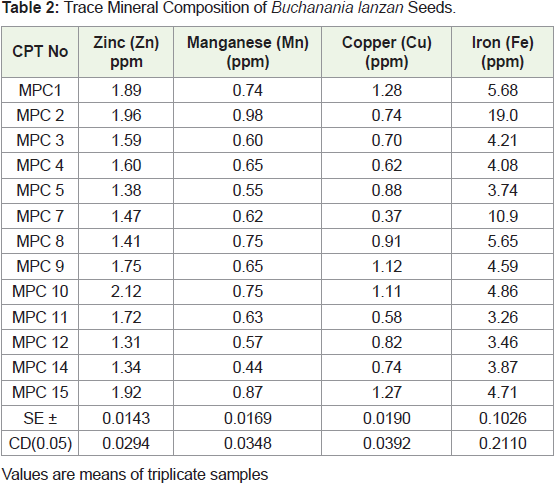Research Article
Nutritional Composition of Buchnania Lanzan Seeds Collected From Candidate plus Trees
Khobragade ND* and Kumbhare V
Forest Research Centre for Skill Development, Chhindwara, Madhya Pradesh, India
*Corresponding author: Khobragade ND, Forest Research Centre for Skill Development, Chhindwara, Madhya Pradesh, India;
E-mail: nagesh_khobragade@rediffmail.com
Article Information: Submission: 20/04/2022; Accepted: 13/05/2022; Published: 17/05/2022
Copyright: © 2022 Khobragade ND, et al. This is an open access article distributed under the Creative Commons Attribution License,
which permits unrestricted use, distribution, and reproduction in any medium, provided the original work is properly cited.
Abstract
The study was carried out to evaluate the nutrition contents of Buchanania lanzan (Chironji) seeds obtained from thirteen candidate plus trees (CPTs) and
analyzed for its nutritional composition. It was observed that total carbohydrate content ranged from 3.30g/100g (MPC-11) to 30.83g/100g (MPC-9), fatty oil
and the content ranged from 39.7% (MPC-14) to 56.2% (MPC-8), ash content in defatted seeds ranged from 5.4% (MPC-11) to 32% (MPC-3), ascorbic acid
content ranged from 9.3 mg/100g (MPC-2, 3, 7, 11, 12) to 17.6 mg/100g (MPC-10), phenol content was 339.6 mg/100g being found in MPC-14 and lowest
content of 98.27 mg/100g was observed in MPC-9 and tannin content ranged from 56.60 mg/100g (MPC-9) to 577.3 mg/100g (MPC-8). Trace elements
zinc content ranged from 1.31 ppm (MPC-12) to 2.12 ppm (MPC-10), Manganese content ranged from 0.44 ppm (MPC-14) to 0.98 ppm (MPC-2), Copper
content ranged from 0.37 ppm to 1.28 ppm and Iron content ranged from 3.26 ppm (MPC-11) to 19 ppm (MPC-2). Based on the results obtained from the
study, it can be concluded that the seeds of B. lanzan provide good opportunities to develop value added products, dietary supplements and phytotherapeutic
compounds. MPC-8 was found to be the best source in respect of oil, carbohydrates and tannin content followed by MPC-10 and MPC-2 for ascorbic acid
and trace minerals.
Keywords
Nutrition; Phytochemicals; Trace elements; Chironji seeds
Introduction
Buchnania lanzan Spreng commonly known as achar, char or
chironji is an important multipurpose tree species belonging to the
family Anacardiaceae. It is a moderate sized tree with a straight trunk,
and useful for clothing dry hills. It is commonly found growing
in association with Shorea robusta, Anogeissus latifolia and other
deciduous trees in mixed deciduous forests. The tree grows on a variety
of soil and attains a height up to 15m to 20m and girth up to 1.25m.
The pulp of the fruit is edible. The seed after drying is used commonly
in the preparation of sweets. It is also suitable as an agro forestry
tree species and plays important role in the rural and tribal economy
[1-3]. Rural people, particularly the indigenous collect the fruits to
earn their livelihood and the species is recognized as a major income
earning species of Eastern and Central India. The dried seeds are sold
at one thousand two hundred rupees per kilogram. However, due to
heavy biotic pressure, poor germination, slow growth of the species
and lack of knowledge of its nursery and propagation techniques,
plantations are not commonly raised either by forest department or
by private tree growers. Therefore, the species is getting depleted fast
from forest and non forest areas. At present the plant is grouped as
an underexploited and non-nationalized minor forest produce. It is
free for collection, as a result of which the local inhabitants, traders
and greedy merchants destroy the branches/whole trees during
collection of its fruits without bothering about the health of the tree.
This has led to the destruction of chironji plants in the forests. There
is an urgent need to develop a technology for easy multiplication and
regeneration of chironji, and to popularize its importance among
local inhabitants/tribals.
Chironji originated in the Indian sub-continent [4]. The species is
found naturally occurring in the tropical deciduous forests of north,
western and central India mostly in the state of Madhya Pradesh,
Bihar, Orissa, Andhra Pradesh, Chhattisgarh, Jharkhand, Gujrat,
Rajastan and Maharashtra. It is commonly found in dry deciduous
forests up to an altitude of 1200 meters, and in sub-Himalayan tracts
up to 900m. In central India, it is commonly associated with teak, sal
in mixed forests.
The bark is dark gray or black, regularly divided into small
rectangular plates, somewhat resembling a crocodile hide and is
reddish inside. Buchanania lanzan is also a multipurpose tree. The
wood is used in making boxes and cheap furniture. It has been
reported to be suitable for match industry. It is used as a fuel, fodder
especially for buffaloes, alternative host for Kusmi lac insect, and oil
for cosmetics and soaps. Its oil is also used as edible oil by tribals.
The seeds contain oil and protein. Seeds/ kernel of Buchanania
lanzan are nutritional, palatable and used as a substitute of almonds
in confectionery. They yield a fatty oil known as “Chironji oil” and
substituted for olive and “Almond oils”, both in confectionery and
indigenous medicines used for glandular swellings of neck. The
kernels, which have a flavor somewhat between that of pistachio
and almonds, are eaten raw or roasted and are commonly used in
the preparation of milk-based sweet meal and puddings. Fruits are
laxative and used to relieve thirst, burning of the body and fever.
Kernels of fruits are used as an ointment in skin diseases. Thus, keeping
in view nutritional composition of Buchnania lanzan seeds at initial
level, the present study was undertaken.
Materials and methods
Collection and preparation of samples:
B. lanzan fruits from thirteen candidate plus trees (CPTs)
were collected from Amarwada, Tamia and Batkakhapa ranges of
Chhindwara district of Madhya Pradesh (Figure 1). The fruits were
rubbed and washed to remove the outer pulp and then dried in the
shade for seven days. The dried seeds were dehulled by cracking along
the margins with a piece of pebble to obtain the brown oval-shaped
kernels. The kernels were dried at 60°C for six hours to 5% moisture
level. The kernels from each CPTs were packed in separate cellophane
bags and stored in refrigerator until used for various analysis.Laboratory analysis:
In the analytical laboratory of the Forest Research Centre for Skill
Development, Chhindwara, Madhya Pradesh nutritional composition
of B. lanzan seeds was analyzed using the standard procedures of
the Association of Official Analytical Chemists (AOAC, 1990). The
kernels of B. lanzan were analyzed to determine the carbohydrate,
ash, oil, ascorbic acid, phenol, tannin and trace elements contents.
Determination of carbohydrate content in the sample was estimated
by Anthrone method [5,6]. The percentage of ash content of
the sample was determined according to Association of Official Analytical Chemists (AOAC) method, (1970). The Oil content in the
seeds was estimated according to the method described by Sadasivam
and Manickam [6]. Ascorbic acid content was estimated by the
titrimetric method of Aberg (1958). Trace elements were estimated
by Association of Official Analytical Chemists (AOAC) method,
1970. Tannin content in the sample was estimated according to the
method of Schanderi (1970). Total phenol content in the sample
was estimated by Folin-Ciocalteau reagent [7,8]. The data collected
were subjected to the analysis of variance (ANNOVA) and critical
difference (CD) were calculated by computer programme SX Statistic
PC DOS version 2.0, copyright @ 1985, 1987, NH analytical software.Result and discussion
Collection and chemical analyses of seeds from thirteen
candidate plus trees (CPTs) of B. lanzan has shown its potential
nutritional significance. The results of the study pertaining to the
nutritional parameters of Buchanania lanzan seeds are presented in
Table 1 and 2. The perusal of data reveals that the total carbohydrate
content ranged from 3.30g/100g (MPC-11) to 30.83g/100g (MPC-9)
respectively as tabulated in Table 1. The mean value of carbohydrate
obtained in the present study was 12.81% which is in agreement with
the value (12.96%) reported earlier by Khatoon et al. (7). There were
seven groups in which the means were not significantly different
from one another. Seeds contain moderate amounts of carbohydrates
which is generally available as instant energy source. Seeds were
found to contain rich source of fatty oil and the content ranged from
39.7% (MPC-14) to 56.2% (MPC-8) respectively (Table 1). Amongst
the thirteen CPTs analyzed for fatty oil content, there were five
groups in which the means were not significantly different from one
another. Khatoon et al. (2015) reported 38% of fatty oil in B. lanzan
seeds, while Dwivedi et al. (2012) reported 59% of fatty oil content.
B. lanzanseeds harvested in the 2nd week of May have been reported
to contain maximum values of (61.66%) of oil (11). Oil is used to
treat skin diseases, remove spots and blemishes from the face. Seeds
are also medicinally valuable; contribute in ayurvedic and unani
medicine as a nervine tonic, anticough and antileprotic (5). Ash
content in defatted seeds ranged from 5.4% (MPC-11) to 32% (MPC-
3) and results are presented in Table 1. There were eight groups in
which the means were not significantly different from one another.
Khatoon et al. (2015) reported 2.20% of ash in B. lanzan seeds. The
ash values obtained in the present study varies with those reported
earlier by various workers. Ash content represents the total mineral
content in foods. They play an important role from a physicochemical,
technological and nutritional point of view. Ascorbic acid (vitamin -
C) content was estimated in seeds of all thirteen CPTs of B. lanzan
and results are depicted in Table 1. The ascorbic acid content ranged
from 9.3 mg/100g (MPC-2, 3, 7, 11, 12) to 17.6 mg/100g (MPC-10).
There were three groups in which the means were not significantly
different from one another. Dwivedi et al. (2012) have reported 5.0
mg of ascorbic acid in B. lanzan seeds [4].
The phytochemical analysis revealed the presence of phenolics
and tannins in seeds of B. lanzan. Phytochemicals, mainly phenolics
are considered to be the important bioactive compounds. Multiple
biological effects of phenolics are related to its antioxidant activity. These are responsible for a wide range of physiological effects such as anti-allergenic, anti-atherogenic, anti-inflammatory, anti-microbial,
anti-oxidant, cardioprotective and vaso-dilatory effects [9].
Polyphenolics are considered to function as antioxidants by various
mechanisms like donating electrons, free radical scavenging by
H-donation. Hence analyses were performed to find out the potential
of B. lanzan seeds as a candidate for nutraceutical significance. The
highest phenol content was 339.6 mg/100g being found in MPC-
14 and lowest content of 98.27 mg/100g was observed in MPC-9
respectively as depicted in Table 1. There were eight groups in which
the means were not significantly different from one another. Tannins
(commonly referred to as tannic acid) are water soluble polyphenols
that are present in many plant foods. The anti-carcinogenic and
anti-mutagenic potential of tannins may be related to antioxidative
property which is important in protecting cellular oxidative damage
including lipid peroxidation. The generation of superoxide radicals
was reported to be inhibited by tannins and related compounds. The
anti-microbial activities of tannins are well documented. The growth of many fungi, yeast, bacteria and viruses are inhibited by tannins.
In the present study, the tannin content in B. lanzan seed samples
analyzed ranged from 56.60 mg/100g (MPC-9) to 577.3 mg/100g
(MPC-8) respectively. There were twelve groups in which the means
were not significantly different from one another. Khatoon et al.
(2015) reported the tannin content of 0.00425 microgram tannic acid
per milligram of sample. The tannin content of the samples analyzed
in the present study are in accordance to the work reported by earlier
workers.
The trace mineral composition viz. zinc, manganese, copper
and iron were analyzed in B. lanzan seeds and results are depicted
in Table 2. In the present study, zinc content ranged from 1.31
ppm (MPC-12) to 2.12 ppm (MPC-10). Khatoon et al. (2015) has
reported 3.32mg/100g zinc in B. lanzan seeds. Zinc is needed for a
healthy immune system and protects liver from chemical damage.
Manganese was also analyzed in all the thirteen CPTs of B. lanzan
and the content ranged from 0.44 ppm (MPC-14) to 0.98 ppm (MPC-
2) respectively (Table 2). Khatoon et al. (2015) has reported 1.6
mg/100g manganese in B. lanzan seeds. Manganese promotes growth,
development and cell function. It is needed for bone growth, protein
and fat metabolism, healthy nerves and blood sugar regulation and a
healthy immune system. Copper content was also analyzed and the
content ranged from 0.37 ppm to 1.28 ppm as depicted in Table 2.
Khatoon et al. (2015) have reported 1.15 mg/100g copper in B. lanzan
seeds. Copper is involved in respiratory and red blood cell function.
It is needed for healthy nerves and bone development. Iron content
was also analyzed in all thirteen CPTs and the content ranged from
3.26 ppm (MPC-11) to 19 ppm (MPC-2). Khatoon et al. (2015) have
reported 4.8 mg/100g iron in B. lanzan seeds. There were nine groups
in copper and iron in which the means were not significantly different
from one another. Iron is necessary for formation of hemoglobin that
carries oxygen in the blood. It is needed for energy production and a
healthy immune system [10-14].
Conclusion
Based on the results obtained from the study, it can be concluded
that the seeds of B. lanzan provide good opportunities to develop value added products, dietary supplements and phytotherapeutic
compounds. MPC-8 was found to be the best source in respect of oil,
carbohydrates and tannin content followed by MPC-10 and MPC-2
for ascorbic acid and trace minerals.



